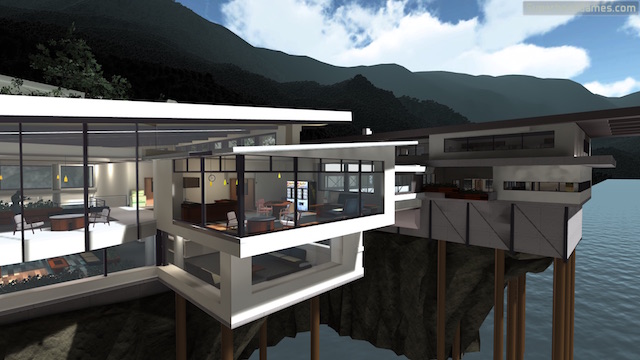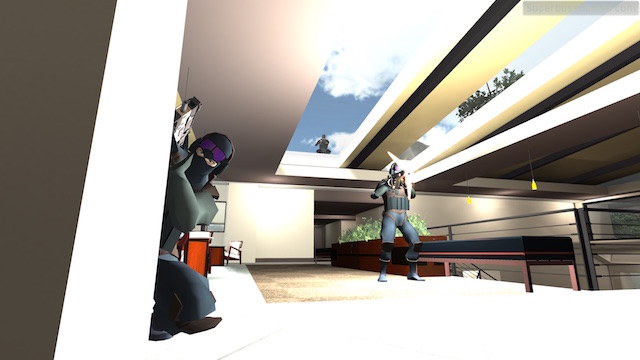Metal Gear Solid V: The Phantom Pain is, for all its faults, one of my favorite games. Adding up my time between that and its predecessor, Ground Zeroes, I’ve put in nearly ninety hours on the Fox Engine’s game’s. MGSV is amazing in the fact that it actually makes you feel like one of the super-soldiers it portrays. It’s fun, it’s engaging, it’s exciting… and the multiplayer sucks.
MGSV‘s multiplayer could technically be played stealthily, but no one does. Everyone runs around shooting and sniping as if it were the latest Call of Duty game. It’s a little infuriating, at least to me, that this incredible game with an amazing stealth engine has a multiplayer mode in which everyone ignores stealth. To be sure, the gunplay in MGSV rocks, and is loads of fun, but playing MGSV for its shooting mechanics is like going to a sushi bar and ordering a hamburger. MGSV made me hungry for a stealth-based multiplayer game where stealth, and not shooting, stole the spotlight.
What I didn’t realize was that one already existed.

Intruder, by Superboss Games, is a game that’s still in alpha but promises to be the best multiplayer stealth experience I’ve ever seen. It’s an FPS that pits two teams against each other: the Intruders, whose goal is to infiltrate and complete a specific task that varies by map, and the Guards, who try to stop this from happening.
What I’ve just described can also describe many other games, so this begs the question: what makes Intruder different from other games that have a similar structure? It all comes down to sound design, believe it or not.
In Intruder, there is no music. There is dead silence. This serves one important purpose: To let you hear your enemy. I’m not talking about gunfire or footsteps, either (though of course you can hear those too), no, I’m talking about their communications. You see, talking to your teammates in Intruder is never safe. Your voice communications are proximity based, meaning that if your teammates are able to hear you, enemies may be able to hear you too. For long-distance communication, each player is equipped with a walkie-talkie they can use to send messages to their teammates. Of course, when you speak into it, you run the risk of enemies hearing you.
In my experience, this led to some very interesting dynamics. On larger maps with good vantage points, I would often play “spotter” for my team at the beginning of the match, and give callouts as to which way the enemy team was moving. I would stay behind in spawn for this sole purpose and spend the first five minutes of the game looking through a pair of binoculars, watching little dots on the horizon. My team didn’t have to shout out to each other to figure out what was going on – I was their eye in the sky, and they were able to maintain radio silence. Most of the time that my team followed this strategy, we were able to take our enemies out, regardless of which team we were on.
This confirmed one thing in my mind: Intruder is a game about stealth and communication, and not about shootin’ dudes.

Another point that drives this home is how similar the Guards and Intruders both look. They both have form-fitting dark uniforms with minimal body exposed. The only real difference between the two uniforms is that the Guards have purple safety glasses on and the intruders do not. This becomes a real issue when half the game takes place in the darkness, making it occasionally very difficult to tell if the guy you have your crosshairs on is a friend or foe. Do you dare call out and potentially give away your position, or do you wait to see and potentially miss your shot? These are the moment-to-moment decisions that make the game such a tense experience.
The game’s varied maps really drive home the solidity of the core mechanics. Small maps emphasize moving swiftly and silently to objectives before the enemy can catch on, but can also set the stage for more drawn-out deadlocked fights if you get caught. Large maps emphasize the many routes available for penetrating the enemy base and reward taking unorthodox routes to your destination. Personally, I enjoy the larger maps more, simply because there are more options, and less chance of things winding up as a five-on-five shootout down a long hallway. Importantly, though, there are branching paths and winding ventilation systems in every map, meaning that there are ten or twenty ways to get from point A to point B at any given time. As a big fan of movement mechanics, that makes me very happy. That being said, there’s nothing more infuriating than spectating a teammate who has no idea where to go, and ends up wandering around aimlessly in the vents for ten minutes. Also, the game his zip-lines. Lots and lots of ziplines.

Another thing I can appreciate about this game is that it does not, despite appearances, take itself too seriously. Sure, you can be the sneakiest bastard around, but you’re also given all sorts of fun tools to mess with your enemies. A motion detector/remotely-detonated C4 combo can be deadly, while a big cardboard cut-out of yourself can distract your enemies just long enough for them to give away their position and let you escape. A banana will make enemies slip and fall, while a tear gas grenade reverses all mouse aiming, causing enemies to spray the walls with bullets and pepper their teammates with lead. And, of course, there’s a “play dead” button that instantly ragdolls you – but be careful not to hit your head when you fall or you might really die. There’s potential for all sorts of wacky fun here for casual play and serious play alike.
Of course, I say “potential”. The game is in alpha and will probably be in alpha for a long time to come. The graphics are unpolished, players animate in strange, spine-shattering ways, and I’ve occasionally seen someone fall exactly halfway through the floor of a room, becoming a torso quietly gliding on the carpet. I’ve spawned three-hundred feet from the starting area and immediately fallen to my death, and I’ve seen ragdolls catch on solid walls and vibrate themselves to death. Most importantly, the game needs some way to communicate with all players at the beginning of the match where their objectives are and where they need to get to, even if just for a second. It would help newer players out immensely. The whole experience is a work in progress, and as such is far from perfect.
And yet… The first time I picked it up, I didn’t move from my computer for about seven hours. I was simply unable to break myself away from the game. There’s something exhilarating about outsmarting your enemies and making it to the objective unseen. There’s something exciting about strategizing with your teammates and planning out your route of attack. There’s something about the loose and wild bursts of gunplay that will leave you tense and breathless, dreading every sound and hiding under tables, waiting for your chance to strike, like a spider.

In short, the game lacks polish, but makes up for it in core gameplay mechanics. If you want in on the action, you needn’t look further than Superboss Game’s website, where you can buy into the alpha for as low as ten bucks.
Oops, almost forgot to mention: This game will cost you about as much as a sandwich. I’m sure the devs would appreciate a larger donation if you enjoy the game, but ten dollar buy-in is the bottom line.
If you like stealth, but you also like clickin’ on dudes, give the game a shot. For the low price, I’d say you can’t go wrong.
For more discussion on video games, click here.

Powered by WPeMatico